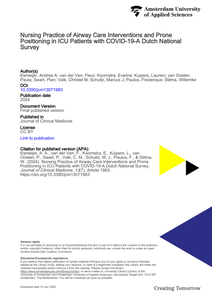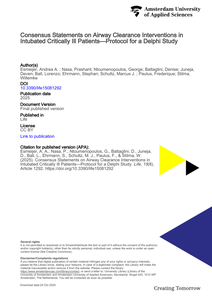Background: Airway care interventions and prone positioning are used in critically ill patients with coronavirus disease 2019 (COVID-19) admitted to the intensive care unit (ICU) to improve oxygenation and facilitate mucus removal. At the onset of the COVID-19 pandemic, the decision-making process regarding the practice of airway care interventions and prone positioning was challenging. Objective: To provide an overview of the practice of airway care interventions and prone positioning during the second wave of the pandemic in the Netherlands. Method: Web-based survey design. Seventy ICU nurses, each representing one intensive care in the Netherlands, were contacted for participation. Potential items were generated based on a literature search and formulated by a multidisciplinary team. Questions were pilot tested for face and construct validity by four intensive care nurses from four different hospitals. Results: The response rate was 53/77 (69%). This survey revealed widespread use of airway care interventions in the Netherlands in COVID-19 patients, despite questionable benefits. Additionally, prone positioning was used in invasively and non-invasively ventilated patients. Conclusions: The use of airway care interventions and prone positioning is time consuming and comes with the production of waste. Further research is needed to assess the effectiveness, workload, and environmental impact of airway care interventions and prone positioning.
DOCUMENT

Airway care interventions may prevent accumulation of airway secretions and promote their evacuation, but evidence is scarce. Interventions include heated humidification, nebulization of mucolytics and/or bronchodilators, manual hyperinflation and use of mechanical insufflation-exsufflation (MI-E). Our aim is to identify current airway care practices for invasively ventilated patients in intensive care units (ICU) in the Netherlands. A self-administered web-based survey was sent to a single pre-appointed representative of all ICUs in the Netherlands. Response rate was 85% (72 ICUs). We found substantial heterogeneity in the intensity and combinations of airway care interventions used. Most (81%) ICUs reported using heated humidification as a routine prophylactic intervention. All (100%) responding ICUs used nebulized mucolytics and/or bronchodilators; however, only 43% ICUs reported nebulization as a routine prophylactic intervention. Most (81%) ICUs used manual hyperinflation, although only initiated with a clinical indication like difficult oxygenation. Few (22%) ICUs used MI-E for invasively ventilated patients. Use was always based on the indication of insufficient cough strength or as a continuation of home use. In the Netherlands, use of routine prophylactic airway care interventions is common despite evidence of no benefit. There is an urgent need for evidence of the benefit of these interventions to inform evidence-based guidelines.
DOCUMENT

Intubated critically ill patients are susceptible to secretion accumulation because of compromised airway clearance. Various airway clearance interventions are employed to prevent complications arising from mucus retention. This Delphi study aims to collect global opinions in an international expert panel of ICU professionals on the usefulness of these various airway clearance interventions. A steering committee performed a literature search informing the formulation of statements. Statements are grouped into two distinct parts: (1) Humidification and Nebulization, and (2) Suctioning and Mucus mobilization techniques. For each part, a diverse panel of 30–40 experts will be selected, with concerted effort to involve experts from various medical specialties involved in airway clearance methods. Multiple choice questions (MCQs) or 7-point Likert-scale statements will be used in the iterative Delphi rounds to reach consensus on various airway clearance interventions. Rounds will continue until stability is achieved for all statements. Consensus will be deemed achieved when a choice in MCQs or a Likert-scale statement achieves ≥75% agreement or disagreement. Starting from the second round of the Delphi process, stability will be assessed using non-parametric χ2 tests or Kruskal–Wallis tests. Stability will be defined by a p-value of ≥0.05.
DOCUMENT
